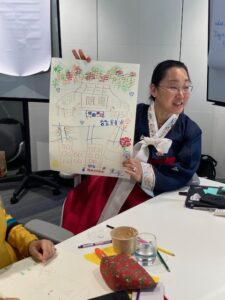Art in Cross-Cultural Training; In today’s globalized world, cross-cultural training is becoming increasingly essential for organizations that work across diverse cultural contexts. The integration of art into this training can enhance understanding, communication, and retention of cultural nuances. By employing artistic modalities, companies can effectively prepare their workforce for the challenges and opportunities that arise in cross-cultural interactions.
Understanding Cross-Cultural Training
Cross-cultural training encompasses various educational strategies aimed at improving individuals’ and teams’ communication and effectiveness in culturally diverse environments. It is a vital aspect of managing multicultural teams and fostering an inclusive workplace where all employees feel valued.
The Importance of Cross-Cultural Training
The significance of cross-cultural training cannot be overstated, especially in multinational organizations. Without proper training, misunderstandings can lead to conflicts, decreased productivity, and lost opportunities. Equipping employees with the skills needed to navigate different cultural landscapes is essential for organizational success.
Moreover, developing cultural competence helps employees build stronger relationships with colleagues, clients, and partners from different backgrounds. This, in turn, can enhance collaboration, creativity, and innovation within multicultural teams. In a world where businesses often operate on a global scale, the ability to understand and appreciate diverse perspectives is not just beneficial; it is crucial for maintaining a competitive edge in the marketplace.
Furthermore, cross-cultural training can significantly impact employee retention and satisfaction. When employees feel understood and respected in their cultural identities, their engagement levels rise, leading to a more harmonious work environment. Organizations that prioritize cultural training often see a decrease in turnover rates, as employees are more likely to stay with a company that values their unique contributions.
Key Elements of Cross-Cultural Training
Effective cross-cultural training includes several key elements:
Cultural Awareness:
Understanding one’s culture and how it affects communication styles.
Communication Skills:
Developing the ability to communicate effectively across cultural boundaries.
Adaptability:
Learning to adjust one’s behaviour in response to different cultural settings.
Empathy:
Cultivating the ability to see things from another’s cultural perspective.
These elements create a solid foundation for further engagement with cultural differences, and they are instrumental in developing effective intercultural relationships. Additionally, incorporating real-world scenarios and role-playing exercises into training sessions can enhance learning outcomes by allowing participants to practice their skills in a safe environment. Such interactive methods not only reinforce theoretical knowledge but also build confidence in applying these skills in everyday situations.
Another critical aspect of cross-cultural training is the ongoing nature of learning. Cultural dynamics are constantly evolving, and what may have been relevant a few years ago might not hold true today. Therefore, organizations should consider implementing continuous training programs that adapt to changing cultural contexts and promote lifelong learning among employees. This commitment to ongoing education ensures that teams remain agile and responsive to the diverse needs of their global workforce.
The Role of Art in Learning and Communication
Art has long been recognized as a powerful medium for expression and communication. Its role in learning environments is profound, given its ability to transcend language barriers and stimulate cognitive engagement.
Art as a Universal Language
Art serves as a universal language that can connect people from various backgrounds and cultures. Visual arts, music, dance, theatre, and literature can express emotions, ideas, and experiences that might be challenging to articulate through words alone.
This universality allows for shared experiences among individuals, fostering empathy and understanding. By incorporating art into cross-cultural training, learners have the opportunity to explore diverse perspectives and create connections that might otherwise remain unattainable. For instance, a collaborative mural project can bring together students from different ethnic backgrounds, allowing them to share their stories and traditions visually, thus enriching the learning experience and promoting a sense of community.
The Cognitive Benefits of Art in Learning
Engaging with art can enhance cognitive functions and facilitate deeper learning. Various studies suggest that involvement in artistic activities promotes critical thinking, problem-solving, and creative expression.
Additionally, art encourages active participation and engagement, making learning more memorable. When learners interact with art, they develop skills such as observation, interpretation, and reflection, all of which are vital in cross-cultural contexts. Furthermore, the process of creating art can lead to improved emotional regulation and resilience, as individuals learn to navigate their feelings and express them through creative outlets. This emotional intelligence is particularly beneficial in collaborative settings, where understanding and managing one’s emotions can significantly impact group dynamics and outcomes.
Moreover, integrating art into educational curricula can cater to various learning styles, ensuring that all students have the opportunity to thrive. For example, kinesthetic learners may benefit from hands-on art projects, while auditory learners might find inspiration in musical compositions. By embracing the multifaceted nature of art, educators can create inclusive environments that not only enhance academic performance but also nurture personal growth and self-discovery among students.
Integrating Art into Cross-Cultural Training
Integrating art into cross-cultural training programs can significantly enhance the effectiveness of these initiatives. By utilizing artistic modalities, training facilitators can create dynamic and interactive learning experiences.
Selecting Appropriate Art Forms
The first step involves selecting art forms that resonate with the targeted cultural groups. This could include traditional crafts, music styles, dance forms, or contemporary artistic expressions. Understanding the preferences and cultural significance of different art forms is essential for meaningful engagement.
It’s important to ensure that the selected art forms are not only representative of the cultures involved but are also sensitive to any cultural nuances. Collaborating with individuals from these cultures can help ensure that the choices made are appropriate and respectful. For instance, incorporating indigenous art techniques or local folklore can provide deeper insights into the values and histories of the cultures being studied. This approach not only enriches the training experience but also fosters respect and appreciation for the diversity of artistic expressions.
Designing Art-Based Training Activities
Once appropriate art forms are chosen, the next step is to design specific training activities that incorporate these elements. This can include workshops on traditional crafts, group projects that require collaboration in creating art, or even employing role-playing scenarios.
Activities should encourage participants to express their thoughts and feelings, share cultural stories through art, and ultimately find common ground across cultural divides. The goal is to create a participatory environment where individuals can learn from one another while engaging with art. For example, a mural project could be initiated where participants contribute their own artistic interpretations of cultural symbols, leading to discussions about their meanings and significance. Such collaborative efforts not only build teamwork but also allow for a rich exchange of ideas and perspectives, making the learning process more impactful and memorable.

Evaluating the Effectiveness of Art in Cross-Cultural Training
To determine the value of incorporating art into cross-cultural training, it is essential to evaluate its effectiveness systematically. This involves assessing various facets of the learning experience, including participant engagement, knowledge retention, and cultural learning outcomes.
Learning outcomes can be measured using both qualitative and quantitative approaches. Surveys and assessments can help gauge how well participants have absorbed information and whether their cultural competencies have improved.
Moreover, observation during training sessions can provide insights into participant engagement and interaction among diverse groups. Evaluating these outcomes helps in refining future training programs and determining the best practices in art-based learning. For instance, incorporating visual arts, such as painting or sculpture, can stimulate discussions that lead to deeper understanding of cultural nuances. Participants might share personal interpretations of art pieces, revealing their own cultural backgrounds and perspectives, which enriches the learning environment.
Gathering Feedback and Making Improvements
Feedback from participants is vital for continuous improvement. It is important to create avenues for participants to express their thoughts on the arts-based training they received.
By analyzing this feedback, training facilitators can identify what worked well and what did not, adjusting the program accordingly. This iterative process ensures that training remains relevant and effective while also evolving to meet the needs of future learners. Additionally, facilitators can implement focus groups or one-on-one interviews to delve deeper into participants’ experiences, allowing for a more nuanced understanding of how art influences their perceptions and interactions. Such discussions can uncover unexpected insights, such as the impact of collaborative art projects on team dynamics or the role of storytelling in bridging cultural gaps, further enhancing the training curriculum.
Overcoming Challenges in Art-Based Cross-Cultural Training
While incorporating art into cross-cultural training can yield significant benefits, there are also challenges to consider. Addressing these challenges head-on can lead to more effective implementation of art-based methodologies.
Addressing Cultural Sensitivities
Cultural sensitivities must be a top priority when designing and implementing art-based training. Misunderstandings or misrepresentations of a culture through art can lead to offense rather than understanding.
It is crucial to navigate these sensitivities with care, especially when dealing with artwork that holds particular significance in certain cultures. Engagement with cultural representatives during the design phase can assist in minimizing the risk of cultural appropriation or disrespect.
Ensuring Accessibility and Inclusivity in Art-Based Training
Another challenge is ensuring that art-based training is accessible and inclusive for all participants. This involves considering diverse learning styles, language barriers, and physical accessibility of training spaces.
Facilitators should seek to tailor activities that cater to different abilities and experiences, ensuring that every participant can engage meaningfully with the art and the training objectives. By fostering an inclusive environment, organizations can maximize the potential benefits of art in cross-cultural contexts.
In conclusion, integrating Art in Cross-Cultural Training presents an innovative and powerful way to enhance learning, build empathy, and promote cultural understanding. Organizations that invest in these programs are likely to see improved communication and collaboration within their diverse teams, paving the way for a more harmonious workplace.

